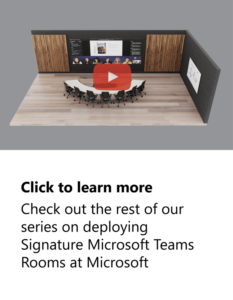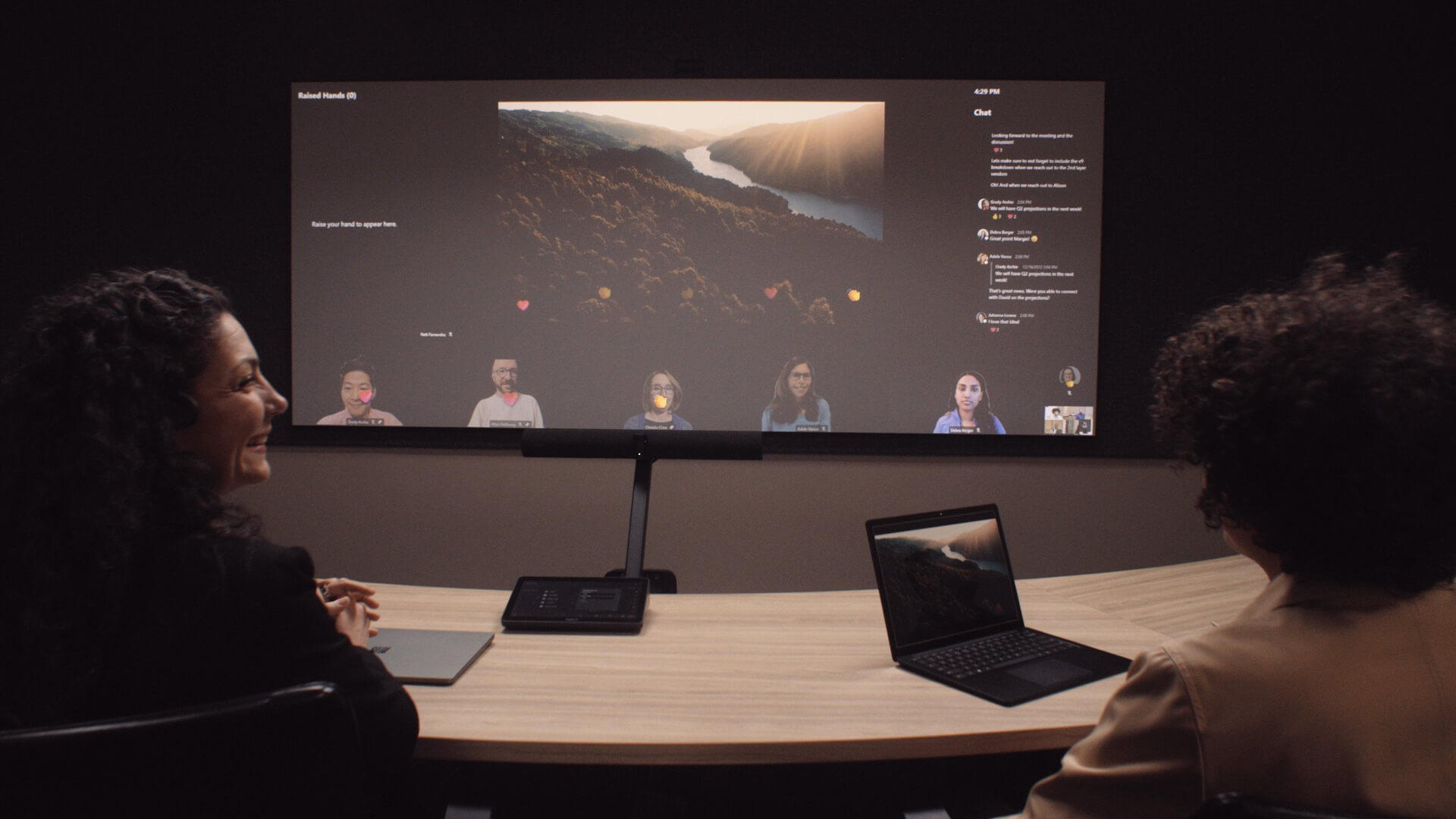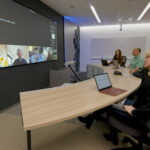 Here at Microsoft, we wanted to improve the experience our employees have in meetings, whether they’re at home, at a coffee shop, or in a meeting room in one of our offices.
Here at Microsoft, we wanted to improve the experience our employees have in meetings, whether they’re at home, at a coffee shop, or in a meeting room in one of our offices.
“It’s been quite the journey over the last few years—we’re very much in a hybrid world,” says Keshav Puttaswamy, a partner director of product management with Microsoft Digital Employee Experience (MDEE), the organization that powers, protects, and transforms the company. “We place a lot of importance on flexibility. We want to make sure our employees are able to do their best work wherever they are.”
That’s why we—the company’s IT organization—worked with the Microsoft Teams product group to develop Signature Microsoft Teams Rooms, our new meeting room technology offering that boosts the meeting experience for everyone, no matter where they join a meeting from.
“Signature Microsoft Teams Rooms are a powerful tool for us to fully embrace this hybrid experience,” Puttaswamy says.
We’re all used to seeing a room with a rectangular table in the middle and a screen on one end. Those kinds of meeting rooms served us really well when we were all mostly in-person. What we’re seeing with hybrid is different needs emerging for employees, and traditional rooms aren’t necessarily the best experience for all meeting types.
—Keshav Puttaswamy, partner director of product management, Microsoft Digital Employee Experience
Designed in The Hive, an incubation space on the Microsoft campus in Redmond, Washington, Signature Microsoft Teams Rooms bridge the gap between in-person and virtual meetings. We’re currently deploying it in a variety of forms across Microsoft.
[Get grounded in our vision for transforming Microsoft with Microsoft Teams. Learn how Microsoft is reinventing the employee experience for a hybrid world. Get a first look at the new hybrid meeting experience at Microsoft.]

Finding the best of both worlds
It’s been fun for the teams involved in this project to re-think what you can do with a traditional meeting room.
“We’re all used to seeing a room with a rectangular table in the middle and a screen on one end,” Puttaswamy says. “Those kinds of meeting rooms served us really well when we were all mostly in-person. What we’re seeing with hybrid is different needs emerging for employees, and traditional rooms aren’t necessarily the best experience for all meeting types.”
Where a traditional space can create connection and allow for nuance, it can also be isolating and exclude remote attendees. A hybrid space needs to serve both worlds.
“When I think about Signature Microsoft Teams Rooms, I just think about trying to build the workplace that our employees really want to be in,” says Matt Hempey, a principal group product manager who supports engagement and collaboration in MDEE. “We know much of our work gets done in meetings, so why shouldn’t we rethink this space where we spend so much of our time?”
Built with a concise arrangement of displays, cameras, audio devices, and specialized tables, Signature Microsoft Teams Rooms amplify the experience for all attendees.
You give off little body language cues when you want to speak. You’ll kinda lean into the table, and everybody around you knows that you want to say something. If you look at the layout of a Signature Teams Room, the physical space itself is designed to facilitate that sort of intuition for the remote participant.
—Greg Baribault, group program manager, Microsoft Teams
Furniture is arranged so that all attendees, whether in-person or remote, face each other. Designed for hybrid meetings, the Front Row display option available in Microsoft Teams Rooms presents remote attendees front-and-center and at eye-level with in-room participants.
The tall 21:9 aspect ratio display leaves enough space to project remote attendees along with shared content and chat space—the meeting within the meeting. This enables in-person attendees to follow along without having to divert their attention.
“You give off little body language cues when you want to speak,” says Greg Baribault, a group program manager with Microsoft Teams, responsible for the Microsoft Teams Rooms product. “You’ll kinda lean into the table, and everybody around you knows that you want to say something. If you look at the layout of a Signature Teams Room, the physical space itself is designed to facilitate that sort of intuition for the remote participant.”

Those participating virtually benefit from the room’s AI-powered cameras. Instead of a single camera feed of a large room filled with small, unidentifiable faces, some AI cameras can identify participants in the room and present them to remote attendees as individuals in the meeting. In the room, in-person participants don’t see themselves on the large display, which can be disconcerting. Signature Teams Rooms create a personalized experience for each attendee based on how they joined the meeting, which makes it far more personal for everyone.
“Some of these features are being driven from the platform Microsoft Teams,” says Sam Albert, a principal product manager responsible for conference room experiences at Microsoft Digital Employee Experience. “Features like spatial audio make it feel like the remote participants are coming to life, and audio is coming from where people are speaking.”
This same technology can light up names of speakers and identify individuals in transcripts.
Upgrading everyone’s experience

Deploying Signature Teams Rooms in new construction makes sense.
“From a new construction perspective, building a Signature Teams Room is no more expensive and no more complicated than building any meeting room,” Hempey says.
It’s not always feasible when it comes to existing rooms if you are budget constrained, and there’s still a need for traditional conference spaces.
“Not every room needs to be converted to a Signature Microsoft Teams Room to improve the experience for employees,” Hempey says. “That’s why we’re deploying a variety of solutions.”
Additionally, connecting all the audio-video equipment to your device can often be a hassle. So, we’re trying to figure out how to eliminate cables entirely.
“It actually made rooms more approachable and reduced the stress that people had of presenting,” Baribault says. “I just go in, either tap the console to start my meeting if it’s scheduled already, or just being in the meeting on my personal device allows me to just click ‘Join’ and cast into the room.”
We want to make it as easy as possible for our customers to build these experiences on their own campuses. All of the technology that we’re putting in our conferences rooms today use Microsoft Teams-certified devices. They’ve been rigorously tested, so we can take different components and also have some flexibility.
—Sam Albert, principal product manager, conference room experiences, Microsoft Digital Employee Experience
Investments in cameras and audio devices that are equipped with AI allow rooms to make decisions on behalf of participants, further easing the need for attendees to control conference systems. These upgrades also improve the experience for remote attendees, as AI can help remove background sounds, blur backgrounds, recognize faces, and find the best angles and framing of participants.
Watch to see how we’re deploying Signature Microsoft Teams Rooms technology internally at Microsoft.Guidelines around the principles we’re applying to our own spaces are being made available to everyone.
“We want to make it as easy as possible for our customers to build these experiences on their own campuses,” Albert says. “All of the technology that we’re putting in our conferences rooms today use Microsoft Teams-certified devices. They’ve been rigorously tested, so we can take different components and also have some flexibility.”
Whether it be a Signature Microsoft Teams Room or one of the other upgraded conference experiences, Microsoft is delivering on the promise of what a workplace can be. This includes building out the toolbox to improve hybrid experiences and enabling the connection that made us successful in the first place.
We didn’t design Signature Microsoft Teams Rooms around specific furniture, devices, or a cost or price point; we designed them around interaction and experience principles. We don’t need to create everything from the ground up. We can make small adjustments to spaces and have a significant improvement.
—Matt Hempey, principal group product manager, engagement and collaboration, Microsoft Digital Employee Experience
“We’re very thoughtful around what we can do with the existing rooms, so we look at more creative ways to bring the benefits of Signature Microsoft Teams Rooms to everyone,” Puttaswamy says. “Even equipping an existing room with a guitar pick-like table enables meeting room attendees to face remote attendees without changing out lighting or incurring heavy construction costs.”
Having the highly modular and flexible platform of Microsoft Teams as a starting place enables different devices and arrangements to develop into real solutions. This allows anyone to create improved hybrid experiences at any price range.
“We didn’t design Signature Microsoft Teams Rooms around specific furniture, devices, or a cost or price point; we designed them around interaction and experience principles,” Hempey says. “We don’t need to create everything from the ground up. We can make small adjustments to spaces and have a significant improvement.”

- Inclusivity is key for giving virtual attendees a good meeting experience. Similarly, connection is still a big part of collaboration. Arrange spaces to include virtual attendees and improve connection.
- You don’t need to break the bank. Simple scenarios, like re-arranging a space so that attendees face the camera when looking at a screen, have real impact.
- When building a new space, consider designing it with hybrid experiences in mind. The costs are equivalent to new construction.
- Using Microsoft Teams and Teams-certified devices gives you a lot of flexibility when building out new hybrid conference rooms experiences.

- Get grounded in our vision for transforming Microsoft with Microsoft Teams.
- Click to watch our first two videos and read the full series on deploying Signature Microsoft Teams Rooms at Microsoft.
- Learn how to configure a Signature Microsoft Teams Room, including Teams Rooms device and solution uses, layouts, and specifications.
- Learn how Microsoft is reinventing the employee experience for a hybrid world.
Tags: deployment, digital transformation, Employee Experience, Microsoft Teams








